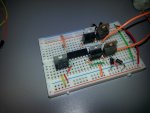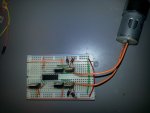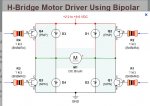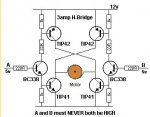plasmaninjaa
Member
Hi,
All I need to do is control the direction that a DC motor is spinning.
Every time I hook it up, there is ZERO response from the motor and the darlington transistors heat up to the point of smoking.
I have checked my wiring a million times but no luck.
See the attached pictures.


The two transistors closest to the motor are the tip122
the other two transistors are the tip127
the power is a 12v battery with a 5v regulator for the picaxe.
This is the schematic I was following: http://static.electro-tech-online.com/imgcache/3422-hbridge4IO.png
I have also tried this schematic with no luck: http://www.talkingelectronics.com/projects/200TrCcts/images101-200/H-Bridge-4.gif
my code for now is to just make the motor change direction every second
main:
high b.5
high c.1
low b.4
low c.0
pause 1000
low b.5
low c.1
high b.4
high c.0
pause 1000
goto main
I am not sure whether I should be turning on pin b.5+c.1 and b.4+c.0 on at the same time or vice versa, however I have tried both and neither work.
I am at a loss as to what I am doing wrong. Solutions would be greatly appreciated!
All I need to do is control the direction that a DC motor is spinning.
Every time I hook it up, there is ZERO response from the motor and the darlington transistors heat up to the point of smoking.
I have checked my wiring a million times but no luck.
See the attached pictures.


The two transistors closest to the motor are the tip122
the other two transistors are the tip127
the power is a 12v battery with a 5v regulator for the picaxe.
This is the schematic I was following: http://static.electro-tech-online.com/imgcache/3422-hbridge4IO.png
I have also tried this schematic with no luck: http://www.talkingelectronics.com/projects/200TrCcts/images101-200/H-Bridge-4.gif
my code for now is to just make the motor change direction every second
main:
high b.5
high c.1
low b.4
low c.0
pause 1000
low b.5
low c.1
high b.4
high c.0
pause 1000
goto main
I am not sure whether I should be turning on pin b.5+c.1 and b.4+c.0 on at the same time or vice versa, however I have tried both and neither work.
I am at a loss as to what I am doing wrong. Solutions would be greatly appreciated!



